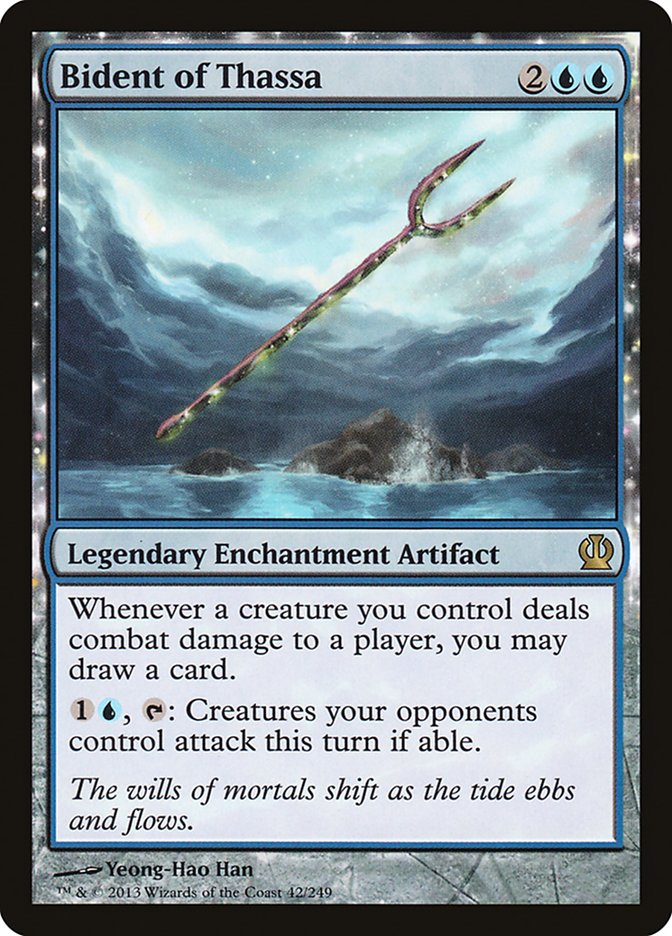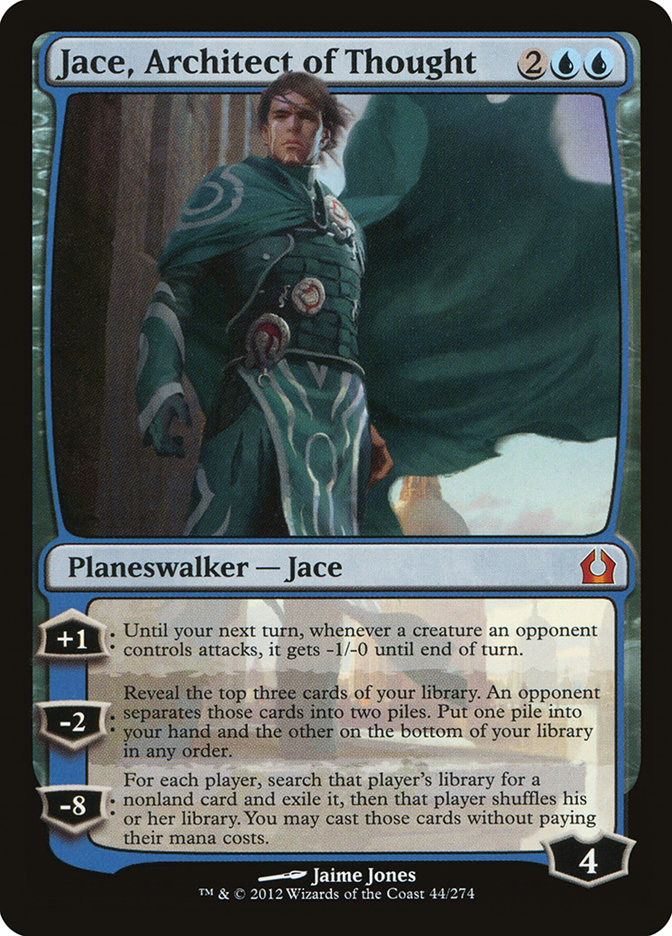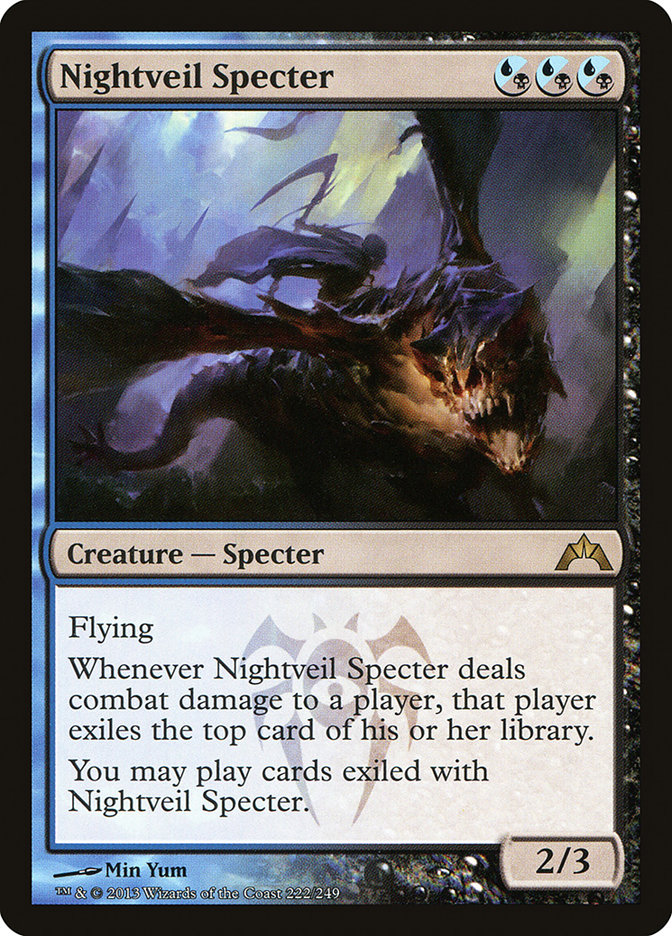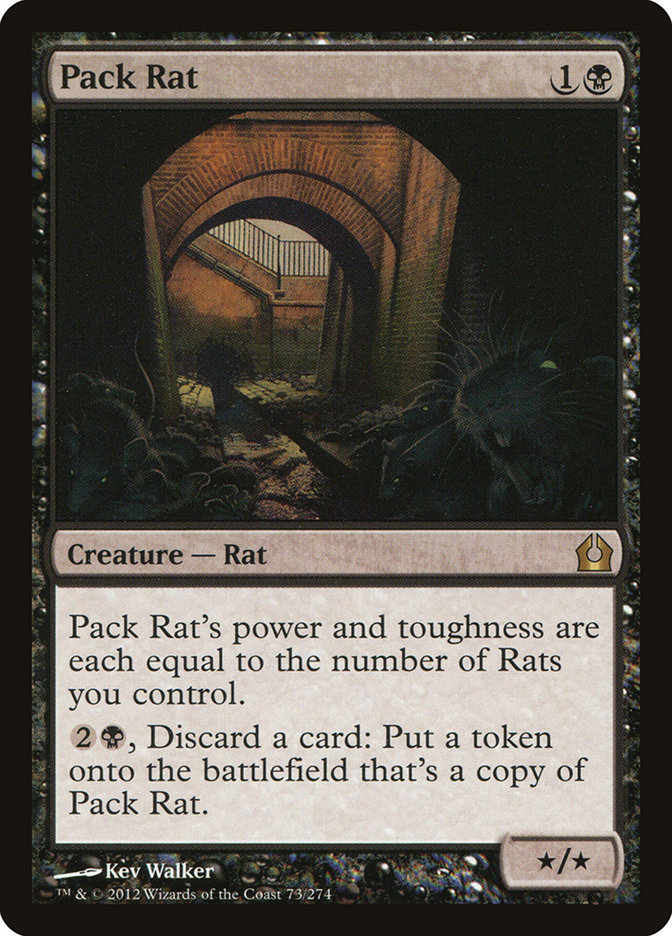They’re coming.
Again?
Yes—and soon.
How can you know?
They’ll come. They have.
. . .
One month ago Standard was in the second week of the season, coming off a week 1 dominance by Sphinx’s Revelation primarily out of Esper Control. Many feared that this new Theros-fueled format might be dead on arrival. Sphinx’s Revelation dominated Return to Ravnica Block Constructed, and now it appeared that another format might fall victim to it.
Of course, it took one week of Esper Control being on top with a target on its head for the format to adjust. The StarCityGames.com Standard Open in Cleveland one month ago was populated by a diverse mix of B/R/W Midrange, Naya Aggro, G/W Aggro, Mono-Red Aggro, and more. The diversity made it impossible for the control decks to be set up well against all of them. Efficient cheap creatures that are each serious threats made three-cost removal and sweepers unreliable. Enchantment removal made Detention Sphere a liability. Burning Earth punished Esper’s three-color mana base. Threats ranged from Rakdos’s Return and Chandra, Pyromaster to Domri Rade and Voice of Resurgence; it was just too much to try to react to.
For reference, here is the Top 8 of the SCG Standard Open in Cleveland exactly one month ago:
1st G/W Aggro
2nd Junk Midrange
3rd Naya Aggro
4th Mono-Green Aggro
5th B/W Midrange
6th Mono-Red Aggro
7th B/R/W Midrange
8th G/W Aggro
With just two weeks of data, many did not believe in the downfall of our so-called hero Esper Control. The following week? Well, that was Pro Tour Theros. While Esper was technically the most-played deck, it was still just ten percent of the field. Other archetypes were further divided into smaller subcategories as players speculated on what the next stage of evolution was supposed to be.
Of course, with the benefit of hindsight, it was clear that two major families of archetypes would dominate Pro Tour Theros:
- Devotion decks: Nearly monocolor all-permanent decks featuring Gods; Nykthos, Shrine to Nyx; and planeswalkers.
- Black decks: Black midrange decks featuring Thoughtseize, Doom Blade, Hero’s Downfall, and Desecration Demon.
Blue, Green, and Red Devotion preyed on the popularity of anti-control creature decks. They had an almost combo-like element to them and were able to go over the top of all of the non-interactive “fair” decks. Their only weaknesses? The first was a terrible weakness to Esper and other control decks (with the exception of Red Devotion, which instead had a weakness to the other Devotion decks). Of course, with control at a low point, this was the perfect weakness to have.
The best of the Devotion decks? Those devoted to Thassa, God of the Sea:
Creatures (27)
- 3 Judge's Familiar
- 4 Frostburn Weird
- 4 Cloudfin Raptor
- 4 Nightveil Specter
- 4 Tidebinder Mage
- 4 Thassa, God of the Sea
- 4 Master of Waves
Planeswalkers (2)
Lands (25)
Spells (6)

These decks haven’t really changed much since the Pro Tour, though it’s worth noting the now-standard split of two Bident of Thassas and two Jace, Architect of Thoughts maindeck. Why? Bident is truly exceptional, but in a world with so many black midrange and control decks, it is just too dangerous to get stuck drawing multiples. When all of your creatures are getting murdered, a second Bident is exceptionally poor.
Devotion’s other weakness? A weakness to the Thoughtseize decks, such as Mono-Black Devotion and B/W Midrange. While Gray Merchant of Asphodel did appear in the Mono-Black Devotion decks, it was not the same sort of animal as the other Devotion decks and really was a black deck through and through. B/W Midrange was a manifestation of the same concepts with a slightly more aggressive bend.
Mono-Blue Devotion proved the strongest of the three “true” Devotion decks, taking the top three spots at the Pro Tour. This painted a target squarely on it, and of all three of the true Devotion decks, it was also the weakest to the black decks. Not surprisingly, the next weekend’s Grand Prix was completely dominated by black decks. Both Mono-Black Devotion and B/W Midrange had excellent win percentages, but it was Mono-Black Devotion that was the clear winner because of its strength in the head-to-head.
Creatures (17)
- 3 Pack Rat
- 4 Desecration Demon
- 4 Nightveil Specter
- 4 Gray Merchant of Asphodel
- 2 Erebos, God of the Dead
Lands (25)
Spells (18)
Sideboard

Doom Blade is a fine card against B/W Midrange and nearly dead against Mono-Black Devotion. Read the Bones is good in attrition matches, but Underworld Connections is even better. Many in the format had replaced some number of their Doom Blades with Ultimate Prices. Mono-Black Devotion now had access to Nightveil Specter, dodging both while providing even more card advantage for fighting attrition. Both decks had access to Thoughtseize, which is capable of beating almost any key card, but Mono-Black Devotion also had Pack Rat, the perfect threat for beating Thoughtseize (well, other than maybe Chandra’s Phoenix).
Oh no! Mono-Black Control had taken over another format! Whatever were we to do? There’s just no beating it! The Devotion decks were even all still present despite being soft to black. Is there anything to be done?
Esper.
Lo and behold, the following week at the SCG Invitational, the format saw a return to Esper Control—but with a few changes. To begin with, Doom Blade was moved completely to the sideboard since players wanted to avoid dead cards against the format’s top dog. Divination increased in popularity to help fight against Thoughtseize. Blood Baron of Vizkopa with its protection from black became a maindeck staple, with players having access to the full playset after board. Detention Sphere returned to fashion to help combat Underworld Connections. Dark Betrayal increased in popularity as a sideboard option.
Creatures (3)
Planeswalkers (5)
Lands (27)
Spells (25)
- 2 Thoughtseize
- 2 Divination
- 4 Azorius Charm
- 4 Supreme Verdict
- 4 Detention Sphere
- 4 Sphinx's Revelation
- 2 Hero's Downfall
- 3 Dissolve
Sideboard

While black decks had beaten Esper Control at the Pro Tour, Esper is the sort of deck that can evolve to beat any one or two enemies. It naturally beats Blue and Green Devotion, and Red Devotion never really hit tier 1. Beating Mono-Black Devotion had actually made Esper weaker against B/W Midrange, but fortunately B/W had fallen away as a worse Mono-Black Devotion in the head-to-head. And what about all of those diverse attacks on Esper we saw week 2?
This is the Top 8 from this past weekend’s SCG Standard Open in Los Angeles:
1st W/R Aggro
2nd R/W Devotion
3rd Esper Control
4th G/W Aggro
5th B/R/W Midrange
6th Mono-Red Aggro
7th Mono-Blue Devotion
8th Naya Control
Look familiar?
Of course, this diverse mix of assaults is informed by the existence of Mono-Black and Mono-Blue Devotion, meaning a slightly different blend, but the spirit is the same. Cheap efficient creatures; Burning Earth; Chandra, Pyromaster; Voice of Resurgence; Rakdos’s Return. The format has once again adjusted to Esper Control.
Let’s take a look at the ways people went about beating Esper Control while not falling behind against Mono-Black Devotion. First stop is the champ, Bennie Beatdowns:
Creatures (26)
- 4 Dryad Militant
- 4 Precinct Captain
- 2 Azorius Arrester
- 4 Boros Elite
- 4 Frontline Medic
- 4 Daring Skyjek
- 4 Soldier of the Pantheon
Planeswalkers (3)
Lands (22)
Spells (9)

“How do you exploit a format full of spot removal? . . . Maybe it’s time for an increase in combat tricks that beat removal, like Gods Willing or Brave the Elements . . . ” —Leaked memo on the future from two weeks ago
Ben’s white aggro deck has a great curve, which is not easy to come by in a White Weenie deck at the moment. White has a real weakness at the two spot unless it embraces a second color. It has Precinct Captain, but after that it falls off hard. Daring Skyjek is the best of the rest, but the drop-off falls quite a bit further after that. It can be tempting to adopt one of the many reasonable gold two-drops. But Ben has just eight sources of red, and half of them can’t be used to curve one into two, which this deck desperately needs to do. Instead, Ben uses Limited seventeenth card Azorius Arrester. It isn’t pretty, but sometimes serving beats is a filthy business.
- Burning Earth in the sideboard? Check!
- Banisher Priest for Gods? Check!
- Anti-black sideboard cards? Check!
- Anti Supreme Verdict and Detention Sphere cards? Check!
- Zero non-threats, like Judge’s Familiar? Check!
Why Boros instead of Mono-White? Boros Charm and Burning Earth are just too valuable against Esper, and Lundquist was willing to do what it takes.
White Weenie isn’t the kind of deck that is going to take over the format, but for filth mongers looking to attack from a different angle, it is a reasonable beatdown option. The Lundquist list is well tuned and would be the starting point I’d use if I wanted to run a Brave the Elements deck.
While the day was won by Boros, another barely Boros deck was not far behind:
Creatures (28)
- 4 Ash Zealot
- 4 Rakdos Cackler
- 4 Frostburn Weird
- 4 Burning-Tree Emissary
- 4 Boros Reckoner
- 4 Stormbreath Dragon
- 4 Fanatic of Mogis
Lands (25)
Spells (7)

There really is a spectrum of red decks, ranging from Mono-Red Aggro (fast) to Red Devotion (big). Gates’ build is of course on the Devotion end of the spectrum. While Red Devotion has never had a week on top, those that played it at the Pro Tour did so largely because of its inherent strength against Esper Control. With Esper at great popularity to fight the other Devotion decks that give it trouble and everyone targeting the black decks that beat it, Red Devotion was poised to make a move.
Additionally, Gates went a very different direction than the G/R Devotion decks from three weeks ago. Instead of Domri Rade and Xenagos, the Reveler, he adopted a light white splash for Chained to the Rocks, Boros Charm, and Assemble the Legion (mostly out of the sideboard).
Interestingly, the other devotion to red payoff Gates wanted? No, not Purphoros, who struggles against black decks, but rather Fanatic of Mogis. The B/W Midrange deck Paul Rietzl and I played in Dublin’s greatest weakness was against Fanatic of Mogis red aggro. With this simple swap combined with access to eight one-drops (unlike many old Red Devotion decks), Gates turned around one of the archetype’s worst matchups (Thoughtseize decks).
While Red Devotion already has an edge on Esper Control, so committed to defeating it was Gates that he even maindecked three (!) copies of Hammer of Purphoros.
The other end of the red spectrum was also present in LA. Old-school player Thomas Pannell piloted the following classic Mono-Red Aggro list:
Creatures (30)
- 4 Chandra's Phoenix
- 4 Gore-House Chainwalker
- 4 Rakdos Cackler
- 4 Burning-Tree Emissary
- 4 Firefist Striker
- 4 Foundry Street Denizen
- 2 Rubblebelt Maaka
- 4 Firedrinker Satyr
Lands (22)
Spells (8)
Sideboard

48 hours before #SCGLA, red deck guru Patrick Sullivan advocated this exact list, noting it as what he would play if he weren’t doing commentary. Patrick Sullivan is a man who knows his red decks.
This list comes out swinging, hitting hard with a super low curve. Thoughtseize? You probably don’t want to Thoughtseize a deck like this. Underworld Connections? Not a good plan.
In addition to the rise of white and red curve decks, this past weekend also saw a resurgence of thee-color midrange decks. First, the week 0 deck to watch, B/R/W Midrange, learning the lessons of Mono-Black Devotion and Orzhov Midrange, is back:
Creatures (10)
Planeswalkers (2)
Lands (26)
Spells (22)
- 2 Thoughtseize
- 1 Doom Blade
- 2 Mizzium Mortars
- 2 Dreadbore
- 1 Rakdos's Return
- 2 Ultimate Price
- 1 Rakdos Keyrune
- 2 Assemble the Legion
- 4 Hero's Downfall
- 2 Whip of Erebos
- 3 Anger of the Gods
Sideboard

This list wisely borrows technology from a lot of other archetypes. To begin with, notice the full eight scry lands. Esper Control isn’t the only deck that should start with eight scry lands, and in fact I would start any three-color deck without one-drops with the full eight—even before shock lands.
Four Hero’s Downfalls? Not a surprising move, though at least mildly interesting given two of the Dreadbores starting in the sideboard.
Pack Rats? It’s spreading . . .
Assemble the Legion? A concession to control, Assemble the Legion after a Thoughtseize (or Duress) is a pretty solid game plan.
Obzedat + Whip? Two great cards on their own, but the combo is backbreaking against black decks and one of the best ways to beat control.
So why aren’t more people playing this list? Outside of a weakness to Burning Earth, this list really is just a fair bit less consistent than the other black decks. The thing is that I’m not sure it needs to be. It might be a good time to return to a few Read the Bones, particularly when you have life gain from Obzedat, Ghost Council; Whip of Erebos; and Blood Baron Vizkopa.
The other three-color midrange deck to Top 8 #SCGLA was a relatively new breed of Naya deck that Brad Nelson unveiled last week on his way to winning the SCG Invitational in Indianapolis.
Creatures (7)
Planeswalkers (6)
Lands (26)
Spells (21)

We see Assemble the Legion again to attack black decks and control. Rather than walk face first into removal spell after removal spell, this new form of Naya contains a host of versatile threats that hit from a million angles.
It’s only creatures? Loxodon Smiter gives us exactly one true “Baneslayer.” Play a lot of spot removal? It will likely be dead. Skimp on it and Smiter becomes a powerhouse. Besides, it is like a removal spell against aggro that happens to not be dead against control.
Stormbreath Dragon gives us a hasty attack that makes Azorius Charm and Detention Sphere look bad. Oh, you cut your Doom Blades? Sorry to hear that . . . This build even has the capability to go long, occasionally playing the Dragon and getting monstrous in the same turn.
Advent of the Wurm is mostly a creature, but being instant speed gives you a powerful anti-aggro creature that can sneak in five damage against control.
Xenagos, the Reveler and Elspeth, Sun’s Champion play into the Assemble the Legion token theme that can often force control to Supreme Verdict, leaving themselves open to the Dragon or Wurm token. Additionally, both walkers have other applications, such as playing defense against aggro decks.
Selesnya Charm is used primarily because of its ability to exile Desecration Demons and Gods, but the option to get an extra body has new value with the increase in Devour Flesh from people that don’t want Doom Blade proper. Additionally, it is yet another instant speed threat, supporting the strategy of sneaking in damage from a variety of different angles against control.
However, it doesn’t stop there. The sideboard continues this “hitting you from awkward angles” theme and pushes it beautifully. Mistcutter Hydra is another anti Azorius Charm/Detention Sphere creature that capitalizes on fewer Doom Blades. That it also punishes Mono-Blue Devotion is an excellent example of getting the most utility you can out of sideboard cards by getting them to do two different jobs.
Soldier of the Pantheon is yet another anti Azorius Charm / Detention Sphere threat but also gives us a great tool against hybrid creatures. The early damage from Soldier of the Pantheon is especially valuable in a deck with so many haste and flash threats.
Ruric Thar, the Unbowed doesn’t have flash or haste, but in a way he provides a third prong to this attack. In the matchups where he comes in, almost any good answer is going to involve Ruric Thar getting at least one big hit in.
Finally, the third and fourth Assemble the Legions allow you to go hog wild against control and black decks. Decks trying to one-for-one are often extremely vulnerable to a big threat of a different sort than they are aiming for. Esper Control does have Detention Sphere. But it’s overworked, and we have enchantment removal. Black has literal zero . . .
Coming full circle, our final deck of the week is the big deck from the last time the format had to beat Esper Control:
Creatures (24)
- 4 Loxodon Smiter
- 4 Experiment One
- 4 Voice of Resurgence
- 4 Fleecemane Lion
- 4 Boon Satyr
- 4 Soldier of the Pantheon
Planeswalkers (2)
Lands (23)
Spells (11)

“. . . combat tricks that beat removal, like Gods Willing or Brave the Elements . . .” G/W Aggro has a solid curve, tons of card quality, and a diverse mix of anti-control threats. Every creature in the deck has a greater power than cost save Voice of Resurgence, and that one’s the most anti-control threat there is.
Boon Satyr, Advent of the Wurm, Selesnya Charm, and Gods Willing give this list an incredible amount of “play.” It’s easy to underestimate them, but I wouldn’t recommend it. Gods Willing is particularly interesting since a month ago everyone played Unflinching Courage instead. This month we have to be tuned against Hero’s Downfall rather than red aggro. The only other major change is Soldier of the Pantheon replacing Dryad Militant, which was inevitable once people learned the card’s strength.
Why did this deck fall off the map last month? It wins maybe three games in twenty against Mono-Blue Devotion, and it isn’t exactly what you want against the other Devotion decks either. It is because of decks like this that Banisher Priest is such an important tool to remember, not just Devotion decks.
So what comes next?
The format is not a hundred percent locked into a loop by any means, but this stage of the cycle is very clearly defined. What happened the last time the format was overrun by white and red creature decks and three-color midrange decks, with Doom Blade out of favor and Esper Control on the decline?
They’re coming.
You know who . . .
Patrick Chapin
“The Innovator”






